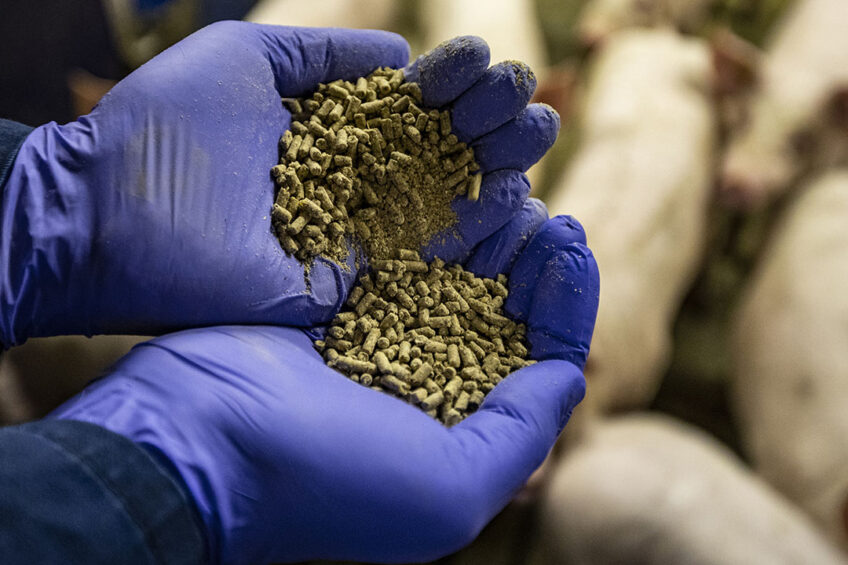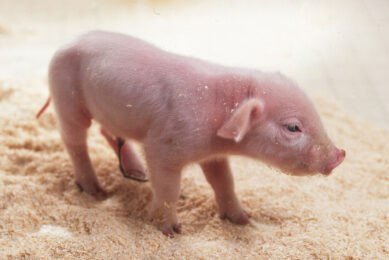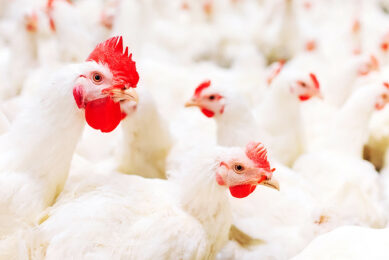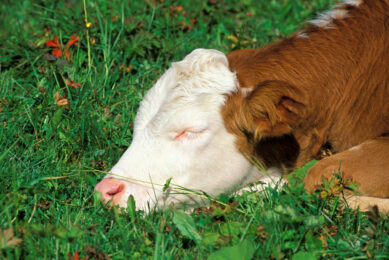Higher-fibre diets in growing pigs and sows

Studies show that there is a need for a better understanding of feeding pigs high-fibre diets and the use of enzymes.
Due to global human population growth, more starch-rich ingredients that used to be more common in livestock feed are increasingly going into food products (and also into biofuel in some cases). In Germany for example, new data shows that animal feed now contains less wheat than it did a year ago.
This means that the feed industry is increasingly turning to ingredients that are more fibrous and research is urgently needed so that feed companies can ensure that livestock get the most out of them. Researchers in the Netherlands, for example, are looking at how feed pellet manufacturers can adjust their processes in order to account for the trend towards less starchy, higher-fibre raw materials.
Wheat millrun
Of course at farm level, using enzymes is a well-established way to boost the nutritional value of more fibrous feed, but their use is not straightforward. They have been shown to be useful to help pigs digest wheat millrun (also called wheat middlings or midds), wheat processing co-products commonly fed to pigs in many parts of the world, especially in Western Canada.
Non-starch polysaccharides (NSP)
Specifically, “pigs do not naturally produce the enzymes required to hydrolyse the non-starch polysaccharides (NSP) in wheat millrun, which limits nutrient absorption,” explains Dr Denise Beaulieu, assistant professor of monogastric nutrition at the University of Saskatchewan in Canada.
NSP enzymes (carbohydrases) break down the cell walls in wheat millrun, releasing the nutrients bound inside. Building on previous studies, Beaulieu and her colleagues have conducted trials with varying amounts fed to growing pigs. The study was led by University of Saskatchewan PhD student Agbee Kpogo, with contributors from the Prairie Swine Centre in Saskatchewan, Olds College in Alberta and the Prairie Agricultural Machinery Institute in Manitoba.
But the study went beyond digestibility. Carbohydrases can potentially also reduce the amount of undigested organic matter in manure (thus reducing greenhouse gas emissions), and perhaps also reduce the amount of methane that’s produced in the pig’s large intestine during wheat middlings fermentation.
Study details
The multi-carbohydrase enzyme consisted of:
- 300 units of glucanase,
- 1,000 units of xylanase,
- 1,900 units of cellulase and
- 4,200 units of amylase.
- In addition, 150 units of a catalyst invertase was added per gram of enzyme.
In the first trial – wheat millrun in the diet was 0%, 15% or 30% with either no enzyme or 1 mg/kg.
Experiments 2 and 3 – involved treatments with 0% and 30% wheat millrun, with and without the enzyme.
Results
Replacing wheat with wheat millrun, with or without the multi-carbohydrase inclusion, did not affect:
- days to market,
- market weight,
- slaughter weight,
- loin depth or dressing percentage.
However, with 30% wheat millrun in the diet, backfat depth was reduced by 7%.
In terms of environmental impact
Pigs fed 30% wheat millrun diets consumed about 22% more water and excreted 31% more manure than pigs fed no wheat millrun. There was no effect from either enzyme supplementation or inclusion of wheat millrun in the diets on GHG emissions, measured when these pigs were housed in environmental chambers at the Prairie Swine Centre.
“Nitrogen and phosphorus digestibility was not improved, and indeed, energy and dry matter digestibility were reduced with enzyme supplementation,” says Kpogo. “This was contrary to our hypothesis and to the results of others.”
Xylanase effect
Kpogo and his colleagues conclude that these results are likely due to the composition and concentration of individual enzymes used in this research. Specifically, xylanase may have been the issue.
Study reported reduced growth
Another group of scientists had previously reported reduced growth when xylanase was fed to weanling pigs, and surmised that the related negative impacts on nutrient digestibility and growth were due to xylanase causing reduced secretion of enzymes by the pig, reduced activity of secreted enzymes or perhaps both. “This is supported by another earlier study where a significant reduction in amylase and lipase activities in piglets’ digesta was observed with xylanase supplementation,” says Kpogo.
What can be added to increase digestibility of wheat millrun?
If xylanase was left out of carbohydrase supplementation because it could negatively affect the level and/or bioactivity of enzymes produced by pigs, would adding glucanase, cellulase and amylase be sufficient to help increase the digestibility of wheat millrun? Beaulieu says that “overall, evidence for the efficacy of xylanase, glucanase, cellulase and amylase – especially in relation to relevant improvements – is inconsistent.”
To review, xylan, which is a major structural polysaccharide in plant cells, makes up anywhere from 5.4% to 8.2% of wheats from around the world, according to Dr Samaneh Azarpajouh (PhD, DVM). It is also primarily responsible for the anti-nutritional effects of wheat.
Looking at various studies, Azarpajouh concluded in an All About Feed story last year that in lactating sows, supplementing xylanase in a coarsely-ground wheat-based diet improves feed intake, nutrient digestibility and subsequent reproductive performance, while reducing body weight loss throughout lactation.
Korean study – increase postprandial satiety
In a new January 2023 review paper of many studies, scientists in the Republic of Korea add that feeding sows a high-fibre diet is the most effective way to increase postprandial satiety, thus improving the welfare of sows subjected to feed restriction during pregnancy. “There are a number of fibrous ingredients available, including wheat middlings, maize germ, sugar beet pulp, maize gluten feed, soy hulls, dried grass and alfalfa meal,” they note. “Findings from previous studies indicated that soluble fibre delays nutrient absorption and decreases physical activity after feeding. In addition to this, it increases volatile fatty acid production, provides energy, and prolongs the feeling of satiety. It also prevents certain stereotypes and thus is paramount to sow welfare.”
Going forward
Clearly there is much work ahead to understand how fibrous ingredients can best be used in pig diets, for sows and various growth stages for market pigs.
“Work with various enzymes and other additives (pre/pro biotics) should continue,” says Beaulieu, “but we also need a greater understanding of the various types of fibres (beyond just soluble and insoluble) and their effect on energy availability, the digestibility of other nutrients and potential health benefits.”
She adds, “this study showed that feeding these high-fibre ingredients does not increase GHG output from the pigs, thus there is potential for an overall reduction in the carbon footprint of pork production with the use of these by ingredients, despite the high fibre.”











